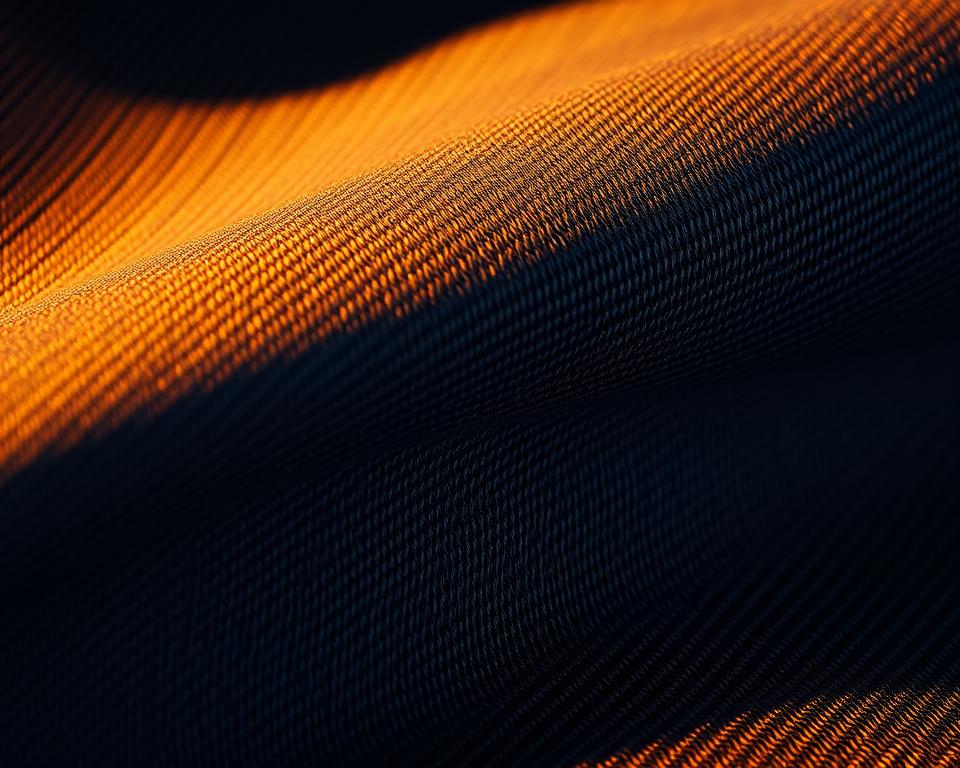Your Guide for Superior denim Edge-to-Edge Textile
Have you ever questioned why some trousers seem as though they are made to last eternity? The secret lies in the elements and artistry. Consider the rising trend of superior selvedge. This isn’t just any fabric—it attests to superiority and tradition.
Nowadays, increasingly more individuals are opting for these classic materials for their robustness and iconic selvedge denim by the yard allure. Be it that you are a DIY sewist or a denim enthusiast, there’s a unique quality about working with high-quality natural fiber and stitching. It’s not just about constructing jeans; it involves fashioning something that tells a story.
Within Core Fabrics, we’ve assembled a selection of 14.25oz certified organic cotton and elastic variants. These materials are tailor-made for everything from raw jeans to designer jacket patterns. Eager to discover the world of premium fabrics? Let’s jump right in.
What Is Denim Selvedge Fabric?
What is it that makes some jeans distinguish themselves with their distinctive, naturally edged borders? The secret is found in the selvedge denim, a premium material celebrated for its durability and vintage charm. Differing from conventional textiles, such material is crafted with classic methods that have stood the test of time.
What Selvedge Denim Means
Selvedge denim is created using old-style shuttle looms, which generate slender widths of about 30-35 inches. These looms weave the material in a method that delivers self-finished edges, often highlighted by a characteristic red line. This method confirms the textile is tightly woven and exceptionally sturdy.
Current looms, in contrast, yield wider textile but lack the same level of artistry. Minor flaws in selvedge, like leg twists or irregular surfaces, are celebrated as features of its character. This ideology, termed “wabi-sabi”, exalts the aesthetic of natural flaws.
The Making of Selvedge Denim
The production of selvedge denim requires a detailed process. Traditional shuttle looms cross the horizontal threads alternately, creating a thick and sturdy fabric. This method contrasts with new-age looms, which emphasize quick production and efficiency over craftsmanship.
Labels such as Karson Denim uphold vintage Japanese craft practices from the 1990s. They deliberately incorporate flaws to maintain the genuineness of the fabric. All products is assessed on a 4-point system, confirming it fulfills the highest standards of superiority.
| Attribute | Selvedge Denim | Contemporary Denim |
|---|---|---|
| Measure | 30-35 inches | 60+ inches |
| Fabrication Method | Shuttle Loom | Contemporary Loom |
| Finish | Irregular, Flawed | Uniform |
| Sturdiness | Exceptional | Standard |
“The beauty of selvedge lies in its imperfections—every imperfection narrates a tale skill and legacy.”
The History of Selvedge Denim
Evolving from simple roots to global acclaim, the narrative of these fabrics is vibrant and motivational. What started as hardwearing clothing in the 17th-century France transformed into a signifier of classic elegance and artistry.
Historical Roots
The foundation of this textile dates back to Nîmes, France, where it was dubbed “serge de Nîmes.” First intended for the working class, it was made from sturdy cotton and yarn. Its resilience rendered it beloved among the workforce during the historic Gold Rush.
During the twentieth century, it had become a staple for trousers. The closure of the Cone Mills White Oak plant served as a catalyst. This change enabled Japanese artisans to reintroduce classic fabric-making practices.

Modern Developments in Denim
Post-WWII, Japan developed a deep appreciation for old-school American culture. Craftsmen restored classic looms to create true reproductions. This commitment to quality ensured the perseverance of selvedge as a specialty product.
Today, breakthroughs from Italy and Turkey have launched eco-friendly combinations and stretch options. These modernizations have expanded the appeal of this timeless material. At Core Fabrics, we gather worldwide, from Montréal to Asia, to deliver to you the finest quality.
“Selvedge’s story is a testament to the perennial merit of quality and tradition.”
Reasons to Select Selvedge Denim?
What makes selvedge denim shine in the universe of top-tier textiles? Its special characteristics and incomparable robustness have made it beloved among lovers and stylists alike. Whether you’re making trousers or a structured jacket, this fabric offers a fusion of tradition and modern appeal.
Distinctive Attributes of Selvedge
Selvedge denim is known for its tight weave, which enhances durability and fade potential. Unlike standard materials, denim selvedge fabric is crafted using classic shuttle looms, yielding a more compact and more durable material. This process ensures that every item possesses a singular finish and individuality.
Key features include:
- Hairy, rigid raw denim contrasts with laundered, relaxed stretch options.
- Through sanforization, sizes become reliable, while raw options offer a shrink-to-fit adventure.
- Weight options range from 9.5oz Eco Finish to 14.25oz Organic, suited for diverse applications.
Durability and Longevity
One of the key attributes of selvedge denim is its long life. The dense fabric structure boosts robustness while enabling distinctive color fades over time. This establishes it as a valuable investment for those in pursuit of classic garments.
Important aspects:
- Fabrics weighing between 12oz and 14oz are perfect for form-fitting jackets and jeans that mellow with time.
- Opt for the 14.25oz True Indigo for traditional jean lifespan.
- Sustainable variants such as recycled cotton combined with indigo blends enhance eco-friendliness.
Core Fabrics offers an assortment of products tailored for every requirement. Spanning from raw finishes to sanforized treatments, each selection is designed for superior quality and value.
Selvedge vs. Wide Denim: A Comparison
In the creation of durable and stylish garments, the selection of textile matters significantly. Among the prevalent selections are selvedge and wide denim, each with unique characteristics. Knowing how they differ assists in selecting the right one for your creation.
Key Differences in Weaving Techniques
Selvedge denim is produced using classic shuttle looms, producing narrow widths of 30-35 inches. This herringbone denim material process generates secure finishes, often marked by a signature red line. Conversely, wide denim employs advanced projectile looms, resulting in widths of 60 inches or more.
Old-style shuttle looms yield roughly 3m per minute, while modern projectile looms reach speeds of 30 meters per minute. The variance in production speed affects both the expense and the finish of the final product.
Advantages and Disadvantages
Selvedge denim is renowned for its high-end construction and robustness. Its limited breadth makes it ideal for applications where defined edges and detail work are sought. However, it can be pricier, generally priced at $23 per meter.
Wide denim is budget-friendly, ranging at $8 per half-meter. Its broader span reduces waste, well-suited to big-scale works like upholstery. However, it does not feature the signature finished border of selvedge.
| Attribute | Selvedge Denim | Wide Denim |
|---|---|---|
| Measurement | 30-35 inches | 60+ inches |
| Weaving Process | Classic Shuttle Loom | Modern Projectile |
| Rate | 3m per minute | 30m per minute |
| Cost | $23/meter | $8/half-meter |
When precise, structured edges are required—as in Grainline Thayer jackets—selvedge wins out. Conversely, wide denim is ideal for extensive projects due to its efficiency. Evaluate your project specifications to choose wisely.
Working with Selvedge Denim
Working with premium materials can elevate your sewing projects to the next level. Whether you are creating pants, jackets, or skirts, grasping fabric quantities, proper sewing methods, and maintenance guarantees a polished result. We will examine ways to best utilize this classic material.
Yardage Needed for Jeans and Jackets
When planning your project, calculating the right amount of material is crucial. For men’s jeans, you’ll need about 3-3.3 yards, accounting for potential defects and shrinkage. Trucker-style jackets generally demand about 3.3 yards, while skirts require only 2 yards.
Creative pattern placement can help manage imperfections in the material. Rather than avoiding imperfections, incorporate them into your pattern for distinctive style.
| Project | Fabric Needed |
|---|---|
| Jeans for Men | 3 to 3.3 yards |
| Trucker-Style Jacket | 3.3 yards |
| Skirt | 2 yards |
Tips for Sewing and Care
The correct gear and skills secure a refined outcome. Select #70-110 pins and presser foot attachments suitable for thick fabrics. Gütermann rPET thread works well for contrasting stitches.
Consider these extra tips:
- Use a tailor’s clapper for sharp creases without shine.
- Our denim kits from Core Fabrics comprise topstitch thread, rivets, and 9mm jeans buttons to ensure a refined result.
- For structured edges, like those in jackets, selvedge is the preferred choice.
Maintaining your pieces properly increases their longevity. Use minimal washing and opt for air drying to preserve fabric quality. Following these guidelines guarantees enduring results.
The Bottom Line
Working with high-end textiles is not solely about longevity; it’s about infusing character. Selvedge denim epitomizes this ideology, blending artisanal charm with enduring excellence. Be it crafting jeans or tailoring a refined jacket, each stitch narrates a tale.
Core Fabrics simplifies your creative journey. Our swatch service lets you touch and test the fabric before deciding. Furthermore, take advantage of free shipping for orders above $150 USD in North America.
Future trends in cotton textiles include sustainable blends and retro washes. These trends offer new ways to add sustainability and style to your wardrobe.
Ready to dive into the world of premium materials? Begin your journey now and appreciate the merit of intentional crafting. Your subsequent creation may well become an enduring classic.


